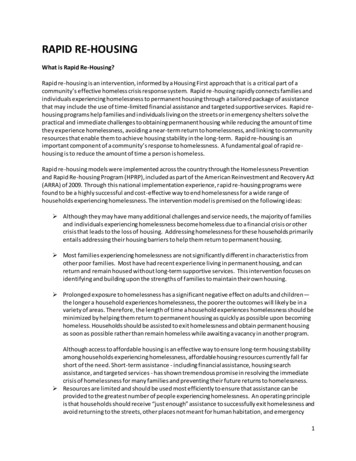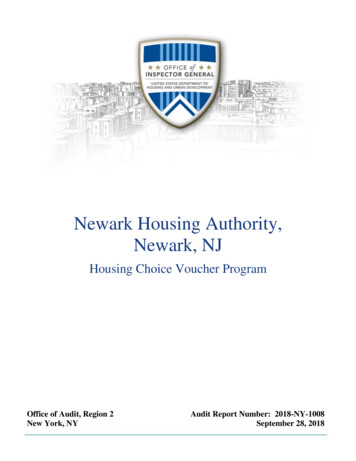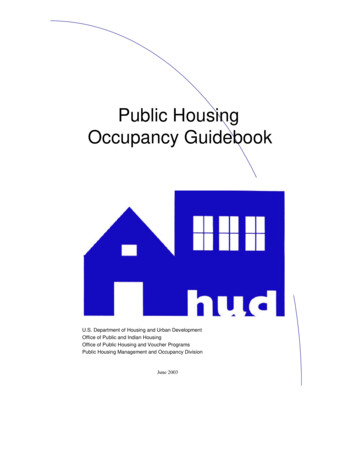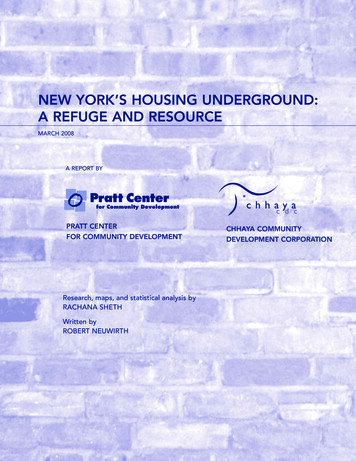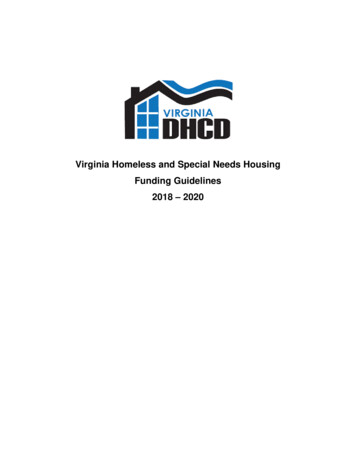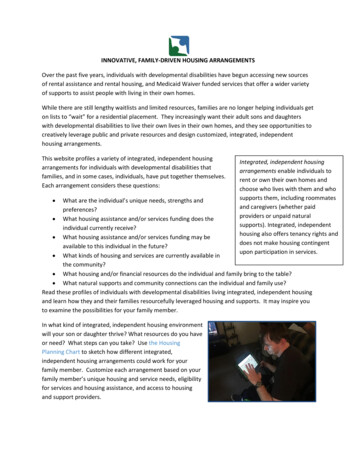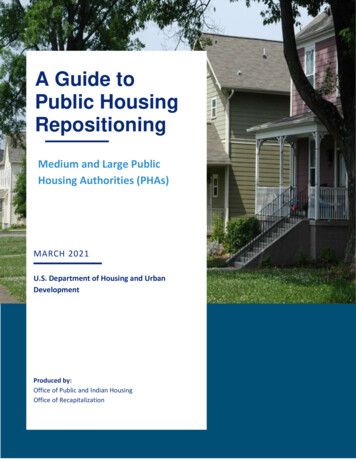
Transcription
A Guide toPublic HousingRepositioningMedium and Large PublicHousing Authorities (PHAs)MARCH 2021U.S. Department of Housing and UrbanDevelopmentProduced by:Office of Public and Indian HousingOffice of Recapitalization1
SECTION 1: INTRODUCTION3SECTION 2: BACKGROUND7SECTION 3: REPOSITIONING OPTIONS13SECTION 4: CHOOSING THE RIGHT OPTIONS FOR YOUR COMMUNITY32SECTION 5: RESIDENT ENGAGEMENT40SECTION 6: CHANGING ROLES42SECTION 7: KEY DATA NEEDED FOR REPOSITIONING PLANNING45APPENDIX I: A REPOSITIONING CONVERSATION WITH TWO LARGE PHAS51APPENDIX II: DETERMINING CONTRACT RENTS58APPENDIX III: IDENTIFYING AND SELECTING PROJECT PARTNERS61APPENDIX IV: ACRONYMS AND KEY TERMS692
Section 1: IntroductionThis Guide to Public Housing Repositioning reviews the different options, and associated planningconsiderations, available to Public Housing Agencies (PHAs) with more than 250 units as they considerthe long-term future of their portfolios. The focus of this Guide is on converting properties currentlyassisted under the Public Housing Program platform to the Section 8 Program platform, i.e., to“reposition” their Public Housing. The Section 8 platform, which is more fully described in Section 2,shares many of the same tenant eligibility requirements, resident protections, and rent computationsas Public Housing but is generally considered to be a more stable financial platform and, because ofthis stability, provides a more reliable income stream for operations and maintenance and betterattracts private investment for capital needs of the property.This Guide is not a comprehensive step by step handbook about how to convert properties, nor is it achecklist of required documents and timelines. Rather, the goal of this Guide is to present all therepositioning options specific to the PHA size in an accessible format to PHAs, their staff, residents, andcommunity members.In addition to this Guide for Medium and Large PHAs, the Department has prepared separate Guidesfor very small PHAs (50 or fewer units) and small PHAs (51-250 units). Each Guide addresses the uniquecharacteristicsandCHOOSING THE RIGHT GUIDEopportunitiesmostChoose the Guide that matches your agency size.appropriate to PHAs ofThe Public Housing Inventory (January 19, 2021)therespectivesizePHA SizeNumber of Number ofShare ofShare ofgrouping.The repositioning optionsto be addressed in thisdocument include: Very Small (1-50units)Small (51-250units)Medium/Large(250 6969,922100.00%100.00%Rental AssistanceDemonstration(RAD) Program;Section 18 Demolition/Disposition;Streamlined Voluntary Conversion; andSection 32 Homeownership ProgramPHAs can use these options alone or in combination to achieve varied repositioning objectives, whichmost larger portfolio repositioning efforts inevitably will require.3
AudienceThis Guide is intended primarily for PHA staff and Board members; however, resident groups, localgovernments, and other stakeholders may also find it a helpful tool on Public Housing repositioning.Why Reposition?Through repositioning, a PHA evaluates what regulatory platform is best suited for the PHA to meetthe long-term affordable housing challenges in its specific community, considering the needs of theresidents, the condition of the real estate portfolio, and the objectives of the PHA and other communityleaders. There are four main reasons PHAs seek to reposition their Public Housing:1. Local Control and Flexibility to Meet Local Needs. Repositioning leads to more local controlover the use of a PHA’s Public Housing assets to reconfigure and finance as needed.2. Administrative Relief. Converting Public Housing to a Section 8 Program, e.g., Housing ChoiceVouchers, Project-Based Vouchers, or Project-Based Rental Assistance, can offer significantregulatory and administrative relief.13. Predictable and Stable Funding Platform. Historically, Section 8 Programs have offered a morereliable and constant funding stream than the traditional Public Housing Program. In someinstances, conversion to Section 8 can also result in higher funding.4. Ability to Leverage. The Section 8 Programs are more conducive to raising debt and equity tohelp an agency achieve strategic goals, from addressing backlog capital needs and building longterm reserves necessary for preservation-oriented life cycle improvements to constructing oracquiring new housing.Changing Platforms – Not Changing MissionsPHAs are local organizations serving the low-income housing needs of their community.Repositioning does not change that core mission. Repositioning simply offers new tools for the PHA tobetter meet local needs. While differences in program reporting and other requirements maynecessitate, say, retraining staff or changing agency software programs, there is no change to the legalstructure of the PHA as a result of the change in subsidy platform.1Among the program requirements that are unique to public housing are: the Public Housing Assessment System (PHAS),Community Service, Annual/Five Year Plans, HUD-Determined Maintenance Wage Rates, and the need to administer twoseparate subsidy programs (Operating Fund and Capital Fund).4
In most cases, PHAs look to repositioning to preserve long-term, project-based assistance in thecommunity, which could involve recapitalizing the existing structures, building replacement housingon-site, or acquiring/developing off-site replacement housing. However, where eligible and in the bestinterests of both the agency and its residents, repositioning can also mean a conversion to tenantbased assistance (assistance that follows the tenant) or thesale of units to low-income homebuyers. These decisionsREPOSITIONING VS. RECAPITALIZATIONare inherently local and should be shaped by the goals andobjectives of each agency, informed by the programRepositioning is the removal of aproperty from the Public Housingrequirements.Program and replacing it with Section 8assistance.Repositioning vs RecapitalizationRecapitalization is the use of currentTo reposition a Public Housing project means to convert itsagency funds or third-party sources tocomplete necessary physicalassistance under HUD’s Public Housing Program to HUD’simprovements to Public HousingSection 8 Programs. In most cases, this conversion isproperty, often by leveraging theintended to preserve the assets as long-term affordableSection 8 rental assistance.housing although, in some instances, repositioning can alsomean the conversion to tenant-based assistance or the saleof Public Housing units to low-income homebuyers and theaward of replacement vouchers. To recapitalize a Public Housing project means to complete thephysical improvements necessary for long-term viability, whether through agency funds or third-partysources, including debt or equity. Public Housing Recapitalization could also include the acquisition ornew construction of buildings. In both cases, the PHA can decide whether to retain control of theproperty (in some cases directly, in others through an affiliated organization) or whether to jointventure with non-PHA actors.As will be discussed in this Guide, not all repositioning options require the full recapitalization of theproject at time of conversion. In those cases, the PHA can implement the recapitalization at a latertime.PHA ExamplesThe Guide contains examples of different PHA repositioning efforts from around the country.Additionally, Appendix I includes an interview with two large PHAs who have either substantiallyrepositioned or completely repositioned their Public Housing inventories – the Housing Authority ofthe City of Austin (HACA) and the Knoxville Community Development Corporation (KCDC). Both HACAand KCDC decided to convert all units to Section 8 to consolidate operations and improve efficiencies.5
Additional InformationThe Guide provides a general overview of the different program requirements under repositioning.For more detailed information on Public Housing repositioning, please visit the repositioning websiteat https://www.hud.gov/program offices/public indian housing/repositioning or emailrepositioning@hud.gov. At the end of the Guide, in Appendix IV, readers can find a list of Key Termsand Acronyms that will be a helpful reference throughout the different sections.6
Section 2: BackgroundThis section provides background on the Public Housing and Section 8 Programs, focusing specificallyon how the funding structures affect the ability to leverage private debt and equity. The key differenceis that, under a long-term, project-based Section 8 subsidy contract, the rents are predictable andadjust annually for inflation. This predictability, which is absent in the Public Housing Program, isinvaluable for securing financing.Public HousingThe Public Housing Program was established by the United States Housing Act of 1937. Its purpose wasto enable local PHAs created pursuant to state law to provide decent, safe, and sanitary housing forlow-income families. Today, there are about 1 million Public Housing units across the country,administered by approximately 2,850 local PHAs.Each PHA enters into an Annual Contributions Contract (ACC) with HUD. The ACC requires the PHA toabide by all HUD-established program requirements in exchange for HUD assistance. PHAs also enterinto a Cooperation Agreement with local government, establishing a Payment in Lieu of Taxes (PILOT)where, in exchange for the Federal Government agreeing to pay for the construction of the PublicHousing, the local government agrees to a substantial reduction in traditional property taxes. PHAsalso execute a Declaration of Trust (DOT) that restricts the use of any property to low-income housing(for 40 years after the last subsidy has been received for development purposes; 20 years after thelast subsidy used for modernization purposes; and 10 years after the last receipt of Operating Funds )and prohibits the PHA from placing any lien or security interest on the property without HUDapproval.2Initially, Congress authorized the Federal Government to issue bonds to finance the development ofnew Public Housing and PHAs were required to set rents at levels necessary to meet basic operatingcosts, i.e., no Federal subsidies were provided for operations or capital improvements. By the 1950s and 1960s, as properties were aging and as the predominant incomes of new residents werelower, PHAs were no longer able to meet operating needs solely based on the rents that residentscould afford. To protect these families from high rent burdens, the Brooke Amendment toThe Housing and Urban Development Act of 1968 capped tenant rents at 25% of a family’s adjustedincome. The cap has subsequently gone up to 30% of the family’s adjusted income. Althoughessential to reducing tenant rent burdens, the Brooke Amendment accelerated the financial strain on2The DOT is also sometimes referred to as a Declaration of Restrictive Covenant, or DORC, in the case of mixed financedownership.7
Public Housing by reducing revenues. 3 To offset the impact of these reduced rental incomes,Congress, over the next several decades, incrementally introduced a series of programs to provideoperating and capital subsidies. Today, as these efforts have evolved, PHAs receive funding tooperate and improve Public Housing through two separate funding formulas - the Operating Fundand the Capital Fund – which takes the funding appropriated by Congress in any given year anddivides it across eligible Public Housing properties by regulatory formula. The ratio between whatHUD believes is necessary to operating Public Housing and the amount Congress appropriates iscalled the “Operating Fund Pro-Ration.” Over the past several years, it has fluctuated between 82%and 112% of the nationwide portfolio’s needs. The Capital Fund, intended for repairs andmodernization of the buildings themselves, has also fluctuated, as one can see in Figure 1.One consequence of this funding and regulatory system is that it is difficult for PHAs to engage inlong-term planning, given the uncertainty of future funding levels. However, even more importantly,it is difficult under the Public Housing funding structure to seek long-term mortgage capital, which isessential to the construction and preservation of multifamily housing. In fact, the Public HousingProgram, as enacted, was not conceived to rely on private financing. It was not until the mid- 1990sthat PHAs were even permitted to develop Public Housing using other forms of financing (includingLow-Income Housing Tax Credits).4Figure 1: Congressional Appropriations3McCarty, Maggie. 2014. Introduction to Public Housing, Congressional Research Service, January 3.Diaz, Nelson. 1994. Use of Public Housing Funds to Leverage Private Financing. Internal memorandum, U.S. Departmentof Housing and Urban Development, April 8.48
The Section 8 Project-Based Rental Assistance (PBRA) ProgramIn 1974, the Congress introduced the Section 8 Project-Based Rental Assistance (PBRA) Program asthe first truly “deep-subsidy” private rental assistance program. Like Public Housing, the FederalGovernment would make up the difference between the rent that low-income households couldafford to pay and the rental revenue the property needed to operate. Because the FederalGovernment was dealing with private owners in the PBRA context, Congress knew that the PublicHousing appropriations model would not work and agreed to a contract rent for each unit.The Section 8 Program is similarly authorized under the Housing Act of 1937 and, as a result, sharesmany of the same tenant eligibility requirements, resident protections, and tenant-paid rentcomputations as Public Housing. However, it differs dramatically in the structure of the subsidycontract, called the Housing Assistance Payment (HAP) contract. As compared with the PublicHousing ACC, the Section 8 HAP contract: Specifies a “contract rent” for each unit type;Is long-term (generally, 15-40 years), with renewal provisions; andIncludes a mechanism to make annual adjustments to the contract rents to account forinflation.These three conditions were at the heart of the PBRA Section 8 Program. Only with this predictabilitycould Congress get private real estate developers and their lenders to finance, build, and operatelow-income housing. In contrast, in the Public Housing Program, there is no equivalent to a contractrent and the revenue a PHA receives is based on the Operating Fund Pro-Ration and the Capital FundAppropriation. In Public Housing, there is no long-term subsidy contract and there are no guaranteedor automatic annual adjustments for inflation. The Public Housing Program was never designed torely on private financing. The expectation was that PHAs would look exclusively to the FederalGovernment for needed funding beyond tenant rents. Today, about 1.2 million affordable housingunits are subsidized through the PBRA Section 8 Program.The Section 8 Project-Based Voucher (PBV) ProgramWhen Congress enacted the Section 8 Program in 1974, it created both the PBRA program (above) anda Section 8 tenant-based assistance program, known today as the Housing Choice Voucher Program(HCVP or vouchers). This voucher program provides subsidies on behalf of low-income households inrental housing they choose in the rental market. Today, there are about 2.2 million vouchers incirculation nationally.9
In 1998, the Congress amended the voucher program to allow PHAs to use a percentage (originally20%) of their voucher budget authority forproject-based vouchers (PBVs).When Section 8 PBVs are used, the propertyowner agrees to reserve some or all of the unitsin a building for occupancy by PBV-eligiblefamilies. In other words, the PHA and the ownersign a Housing Assistance Payments (HAP)contract to attach PBV rental assistance to thestructure. During the term of the HAP contract,the PHA makes housing assistance payments tothe owner for units leased and occupied byeligible families. Projects are typically selectedfor PBVs through a competitive process managedby the PHA, although in certain cases projectsmay be selected non-competitively.PBV vs. PBRAOne of the biggest conversion decisions for anyPHA that wishes to preserve a former PublicHousing property as affordable housing is thechoice over which form of project-based Section 8assistance to use. Under RAD, PHAs have twooptions – Project-Based Vouchers (PBVs) orProject-Based Rental Assistance (PBRA). UnderSection 18 or SVC conversions, a PHA can onlyconvert to PBVs.For more information about the two options, see“Guide To Choosing Between Project-BasedVouchers (PBVs) And Project-Based RentalAssistance (PBRA) For Public HousingConversions” on the RAD website.Significant changes to the program were enactedin 2000, by the Fiscal Year 2001 AppropriationsAct, and, in 2008, by the Housing and EconomicRecovery Act of 2008. The latest statutorychanges to the PBV program were enacted by the Housing Opportunity Through Modernization Act of2016 (HOTMA).5As currently in effect, some of the key features of the PBV program are:1. PBVs can be used for existing, rehabilitated, or newly constructed housing, with differentrequirements and procedures being applicable in different contexts.2. While generally no more than the greater of 25 units or 25% of the units in any project can beassisted with PBVs, projects recently repositioned from the Public Housing Program are oftenexempt from this requirement; and3. After one year, all PBV households have a right to move with the next available voucher fortenant-based assistance, or what has become known more commonly as ‘Choice-Mobility.’Today, there are about 250,000 PBV units, or around 11% of the voucher program.5A detailed account of the HOTMA changes, and further guidance, is provided under PIH Notice 2017-21, ImplementationGuidance: Housing Opportunity Through Modernization Act of 2016 – Housing Choice Voucher and Project-Based VoucherProvisions, published October 30, 2017.10
SummaryThe Public Housing Program is thePBVS AND REPOSITIONINGoldest Federal housing program. ItThe Section 8 Project-Based Voucher (PBV) program haswas designed to enable localbecome an increasingly important tool for PHAs who areindependent public bodies to ownattempting to convert their Public Housing to Section 8 forand manage housing for low-incomelong-term preservation purposes.households that would beIn response to this increased interest in the PBV program asconstructed with Federal funds anda repositioning tool among PHAs and other stakeholders, theoperated, initially, with tenant rents.Office of Public and Indian Housing (PIH) recently issued theOver time, this basic financial modelfollowing FAQs -- PBVs and Public Housing Repositioning(September 2020) and TPVs for Public Housing Actions (Junebroke down. As Congress attempted2020). These FAQs address a number of important questions,to remedy these problems it was alsoincluding:developing new forms of Federal Under what conditions does the PHA need anhousing assistance that would betterIndependent Entity (IE) to perform rent reasonablenessdeterminations and Housing Quality Standards (HQS)leverage private capital, eventuallyinspections?leading to the Section 8 Program. What if the PHA wants to convert to PBVs and does notWhile the design of the Publicoperate a voucher program today? How does the PHA find aHousing financial model has beenvoucher administrator partner?modified to permit some forms of How is the voucher funding calculated and what if theprojected costs (under the PBV program) are higher than thedebt, the Section 8 Program is muchPHA’s per-unit-costs (PUC) under the regular vouchermore aligned with the full range ofprogram? When the PHA receives its increment of newavailable types of long-term mortgagebudget authority, will it be based on the PUC or on projectedfinancing. As a result, HUD’s focus oncosts? When does the new funding begin?providing the information in thisGuide represents its continued effortIn addition to these valuable FAQs, the Department alsoto assist PHAs to convert from theexpects to publish a Section 8 PBV guidebook.Public Housing platform to Section 8platform to be able to leverage their assets in ways enjoyed by other operators of federally-assistedhousing in order to preserve them as long-term affordable housing.11
LEVERAGING SECTION 18 CONTRACT RENTSHow does converting Public Housing funding to a Section 8 contract rent allow a PHA to leverage privatedebt?A property under a Section 8 contract approaches the repair and replacement of capital needs infundamentally different ways from a property under Public Housing. In the Public Housing program,PHAs rely on direct Federal grants through the Public Housing Capital Fund and allocate that pot of fundsacross their Public Housing stock through capital planning across a portfolio.An owner of property under a Section 8 contract analyzes the capital needs of the property, establishesand funds a capital replacement reserve from project revenue, and draws down from these funds forroutine repairs and replacements. Periodically, the owner also accesses debt, equity, and otherconventionally available capital sources to make more significant improvements to the property,modernizing it for the next 10-20 years. Debt is tied to the specific property and repayment of the debt issupported by the property’s revenue.The HAP contract establishes a “contract rent” that is the revenue the owner will receive through acombination of tenant rents and housing assistance payments. The contract rent remains constant: Iftenant rents go down in any year, the HAP subsidy goes up. If tenant rents rise, the HAP subsidy goesdown. The Section 8 contract provides a reliable, consistent source of revenue for the property tosupport its expenses, replacement reserve deposits, and debt service.These contract rents form a reliable and steady source of revenue that affordable housing lenders andinvestors can underwrite when financing capital investments. Combined with significantly fewerrestrictions on third party liens than in the Public Housing Program, properties under a Section 8 contracthave readily and safely accessed commonly available debt and equity products for decades.The fundamental question for any PHA assessing repositioning options and attempting to preserve orredevelop a property is whether the Section 8 contract rents are enough for the property to coveroperating expenses, make deposits to a replacement reserve, and support any upfront financing neededto bring the property into good physical condition.12
Section 3: Repositioning OptionsThe four main options for converting Public Housing to Section 8, which can often be used incombination, are: The Rental Assistance Demonstration Program (RAD); The Section 18 Demolition or Disposition; The Streamlined Voluntary Conversion (SVC); and The Section 32 Homeownership Program.This section reviews the main elements and requirements of each program.6PROGRAM BASICSRental Assistance Demonstration (RAD) allows PHAs to convert Public Housing to Section 8 PBV or PBRA at contract rentlevels based on the property’s public housing funding. As a preservation program, RAD requires one-for-one replacement ofthe public housing units, with certain limited (“de minimis”) exceptions. All residents have an absolute right to return (no rescreening). To convert, a PHA must submit a financing plan that demonstrates long-term feasibility.Section 18 Demolition or Disposition allows PHAs to demolish or dispose of Public Housing units under certain criteria andentitles the PHA to request Section 8 Tenant Protection Vouchers (TPVs) for any vacant unit occupied by an assistedhousehold within the past 24 months. The PHA can elect to project-base these TPVs, provided the assisted units are offeredto the impacted families. In many communities (but not all) the TPVs result in rents that are higher than the RAD rents. Inthe case of disposition, the units must actually be disposed of, which can be accomplished by transferring the asset to a PHArelated entity for nominal value in order to support affordable housing. Section 18 also qualifies the PHA for certain phase-outfunding under the Public Housing operating and capital programs.Streamlined Voluntary Conversion (SVC) allows a PHA to convert Public Housing assistance to Section 8 vouchers (TPVs),which a PHA must offer to residents as tenant-based vouchers. The TPVs can only be project-based with tenant consent. Aswith Section 18, TPVs may be requested to protect assisted households and for all units occupied by an assisted householdwithin the past 24 months. To be eligible, the PHA must be down to its last 250 Public Housing units and it must agree tocloseout its Public Housing Program.The Section 32 Homeownership Program allows PHAs to dispose of Public Housing to create homeownership opportunitiesfor low-income households. As with Section 18 and SVC, a PHA may request Section 8 vouchers (TPVs) to protect assistedhouseholds and for all vacant units occupied by an assisted household within the past 24 months. A PHA must develop a HUDapproved Homeownership Plan.6For very distressed public housing projects that are also in struggling neighborhoods, PHAs should also consider theChoice Neighborhoods Initiative (CNI) Program. Although, based on recent appropriations, generally only about fourimplementation awards are made annually, the CNI Program helps communities revitalize severely distressed publicand/or assisted housing and catalyzing improvements in the neighborhood. Choice requires hard replacement units, butthe replacement units can be RAD (PBV or PBRA) or non-RAD PBV units (in addition to ACC units), so can be used inconjunction with RAD, Section 18 and Section 22 repositioning tools. Depending on the repositioning tool andreplacement units proposed, Choice can also authorize a new award of TPVs. For more on CNI, click here.13
RADIn 2011, Congress authorized the RAD program, which allowsPHAs to convert their Public Housing to Section 8 assistance.With subsequent Congressional authorizations, HUD now hasthe authority to convert 455,000 Public Housing units toSection 8 under RAD. As of March 2021, 142,688 units havealready converted.Under RAD, a PHA has the option of converting to two formsof long-term project-based Section 8 assistance:Average rehabcost of 60,000per unit forclosedtransactions.PHAs haveleveraged 12.57for every 1 ofPublic Housingfunds put into aconversion Project-Based Rental Assistance (PBRA). This program Figure 2: RAD at a Glance (January 2021)is administered by HUD’s Office of Multifamily Housing.As mentioned earlier, it was the first Section 8 project-based program created by the Congress.It is also by far the largest. Project-Based Vouchers (PBVs). This form of project-based Section 8 is administered by a localvoucher agency. HUD’s PIH Office oversees the voucher agency but is not a direct administratorof the PBV contract. If a PHA does not operate a voucher program but wants to participate inthe PBV program, it will need to partner with a current voucher agency to administer the PBVs.SAMPLE PUBLIC HOUSING RAD CONVERSION PER UNITMONTHLY (PUM)Figure 3: Sample Public Housing RAD Conversion14Congress did not appropriate anyadditional funds for RAD in order toset initial contract rents according tostandard PBRA or PBV approaches.Instead, HUD combines the amountsit receives under the Operating andCapital Fund programs (by project)and adds this combined subsidy(Housing Assistance Payment) to thetenant rents to create the Section 8contract rent.
For example, as shown in Figure 3, assume that a Public Housing project has tenant rents of 250 perunit monthly (PUM). Also assume that it receivesOperating Subsidies of 378 PUM and Capital Funds of2020 RAD Rents 196 PUM. Combined, these amounts add up to 824This file contains the RAD contract rentsPUM. Under RAD, the project will leave (or be removedfor all Public Housing properties. It alsofrom) the Public Housing Program and will have anincludes information on local fair marketinitial Section 8 contract rent of the same amount, 824rents (FMRs). So that PHAs can comparePUM. The Operating Fund and Capital Fund arethe rent levels under differentrepositioning options.replaced with Section 8 Housing Assistance e project will be subject to a long-term HAP contract,/documents/2020 RAD Rents web.xlsxwhich provides annual rent adjustments, and the PHAwill execute a RAD Use Agreement, which ensures that the property is maintained as low-incomehousing.In addition to RAD being a “revenue neutral” program with no new funding, there are six featuresunderpinning the program.1. Preservation. RAD is a “preservation” program, meaning that the intent is to preserve asmany “hard” units (physical units with project-based rental assistance) as possible.Consequently, under RAD, a PHA must retain or replace units on a one-for-one basis, withlimited exceptions.72. Resident Rights and Protections. If the conversion results in no relocation, residents have aright to remain at the property without rescreening. If there is need for relocation due toconstruction, they have a right to return, again with no rescreening. Residents are also entitledto other rights and protections, including consultation, enhanced relocation protections, leaseand grievance protections, and the right to organize.3. Public or Non-Profit Stewardship. To ensure long-term, mission-based oversight of theproperty as affordable housing, all RAD transactions must be owned or controlled by a publicor non-profit body. Most RAD-converted properties remain owned by the PHA. A PHA cancreate a joint-venture with a private entity provided this mission-based oversight is in place. Forexample, the PHA can choose to transfer ownership to a par
A Guide to Public Housing . 2 SECTION 1: INTRODUCTION 3 . Appendix I includes an interview with two large PHAs who have either substantially . on how the funding structures affect the ability to leverage private debt and equity. The key difference is that, under a long-term, pr



